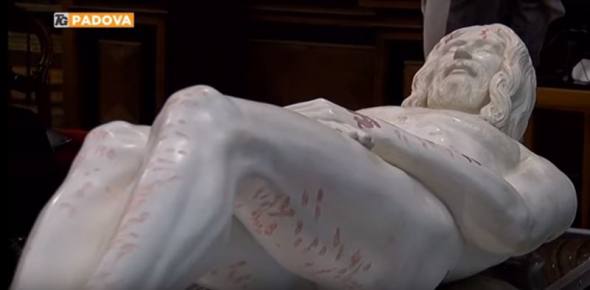An Italian professor has created a 3D image of of the man on the Shroud of Turin, claiming that it is the “precise image of what Jesus looked like on this earth.”
Giulio Fanti, teacher of mechanical and thermal measurements at the University of Padua who has studied the Shroud for several years, unveiled the 3D image last week.
“From now on, He may no longer be depicted without taking this work into account,” stated Fanti, as quoted by the Catholic publication Aleteia.
“According to our studies, Jesus was a man of extraordinary beauty. Long-limbed, but very robust, he was nearly 5 ft. 11 in. tall, whereas the average height at the time was around 5 ft. 5 in. And he had a regal and majestic expression.”
Fanti also explained that the 3D image allowed for an examination of the many wounds that the figure believed by many to be Jesus suffered.
“I counted 370 wounds from the flagellation, without taking into account the wounds on his sides, which the Shroud doesn’t show because it only enveloped the back and front of the body,” continued Fanti.
While it may never be known for sure if the image on the shroud is Jesus, the blood stains are consistent with someone brutally tortured, crucified and layed in a tomb.
“In addition, the three-dimensional reconstruction has made it possible to discover that at the moment of his death, the man of the Shroud sagged down towards the right, because his right shoulder was dislocated so seriously as to injure the nerves.”
Purported to be the cloth that Jesus was buried in after the crucifixion, the Shroud of Turin first appears in the historical record around the year 1360 at the Diocese of Troyes in France. It was eventually moved to the Turin Cathedral in Northern Italy in 1578.
Much debate has existed over the authenticity of the shroud, including whether or not it was from the first century and how the famous image appeared.
In 1988, carbon dating tests were performed on the shroud, which placed its origins in the Medieval era. However, many, including Fanti, have claimed the results were faulty due to laboratory contamination.
In 2013, Fanti along with Italian journalist Saverio Gaeta released a book documenting research on the Shroud, arguing that it was indeed from the time of Jesus and was likely authentic.
Fanti’s views are not without its critics. Roy Speckhardt, executive director of the American Humanist Association, said that he was “very skeptical” of Fanti’s conclusions.
“If the research team at the University of Padua believes that the earlier carbon dating test showing the shroud was from a different era was faulty due to contamination, why not just do another carbon dating analysis?” said Speckhardt.
“If reputable scientists are given the chance to confirm this team’s results by replicating their experiments, then the new estimated date for the shroud would gain credibility. But even if the shroud was dated from the proper time period, that isn’t proof that it was used on Jesus.”
